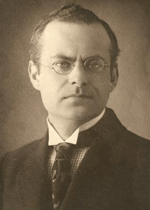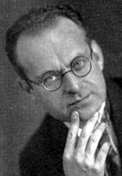Nimzowitsch Aron (07.11.1886 – 16.05.1935)
 Danish world class player born in Riga. Actually wanting to study mathematics, learned chess as an 8-year-old and discovered his talent, when he came in among the winners in Ostend in 1907, Hamburg in 1910 and San Sebastian in 1912 in spite of outstanding participants. After the war, Nimzowitsch lived first in Sweden, then until his death on 16 May 1935 in Copenhagen, where as a result of pneumonia, passed away.
Danish world class player born in Riga. Actually wanting to study mathematics, learned chess as an 8-year-old and discovered his talent, when he came in among the winners in Ostend in 1907, Hamburg in 1910 and San Sebastian in 1912 in spite of outstanding participants. After the war, Nimzowitsch lived first in Sweden, then until his death on 16 May 1935 in Copenhagen, where as a result of pneumonia, passed away.
His most important successes were Marienbad in 1925, Dresden in 1926 (ahead of Alexander Alekhine), Karlsbad in 1929 (ahead of Jose Raul Capablanca). In addition, many victories came in smaller tournaments. With his Colleagues, he was not popular, doing freestanding exercises and headstands during a game, thus hindering his opponents in their concentration, while he himself was hypersensitive against disturbances. As a non-smoker, he refused to tolerate that his opponents smoked and complained to the arbiter already, if somebody put his cigar on the table that “he threatens to smoke”, demanding in such cases immediate attention. Was also consistently concerned about his thesis. He complained about the dogmatic simplifications of the thesis by Tarrasch, but he himself announced his thesis just as irrefutable dogmas.
 Being a great chess player, his invention of the Hypermodern Chess Theory revolutionized chess. Shortly after, Richard Reti, Gyula Breyer, and Savielly Tartakover all joined in. His chess ideas changed forever how chess is played at the highest levels. The main strategies that he innovated are (1) instead of occupying the critical center squares with pawns and/or pieces, to attack them from far away with knights or fianchettoed bishops, (2) to blockade isolated pawns with a knight; and (3) over-protection. These three ideas were so radical at the time that only a few chess players took them seriously. His business card read: A. Niemzowitsch, Candidate for the World Championship of Chess and Crown Prince of the Chess World.
Being a great chess player, his invention of the Hypermodern Chess Theory revolutionized chess. Shortly after, Richard Reti, Gyula Breyer, and Savielly Tartakover all joined in. His chess ideas changed forever how chess is played at the highest levels. The main strategies that he innovated are (1) instead of occupying the critical center squares with pawns and/or pieces, to attack them from far away with knights or fianchettoed bishops, (2) to blockade isolated pawns with a knight; and (3) over-protection. These three ideas were so radical at the time that only a few chess players took them seriously. His business card read: A. Niemzowitsch, Candidate for the World Championship of Chess and Crown Prince of the Chess World.
His major works: Mein System (1925), Die Blockade (1925) andDie Praxis Meines System (1929). “The Immortal Zugzwang Game”.



